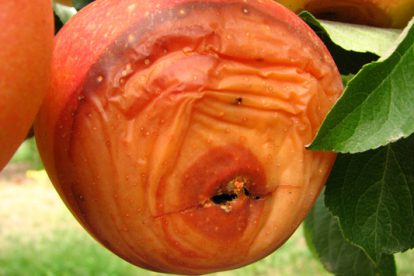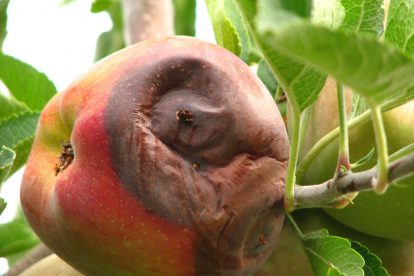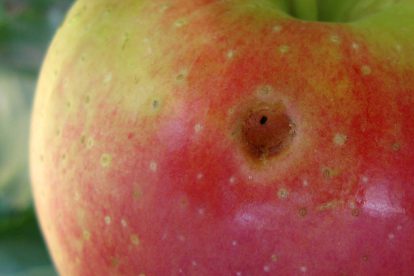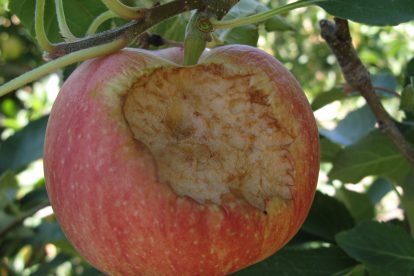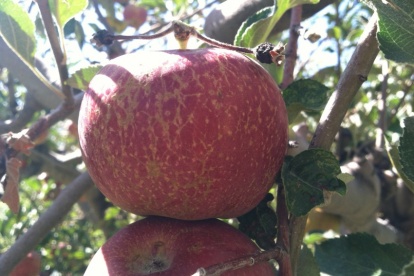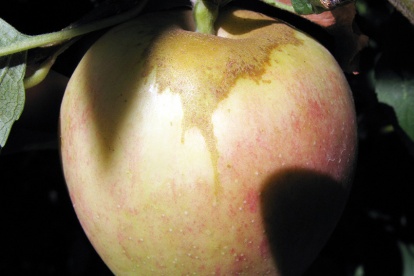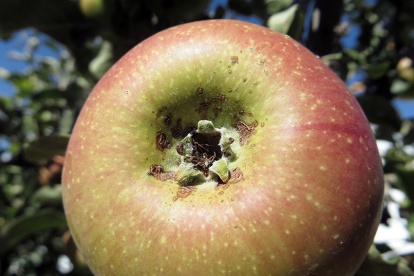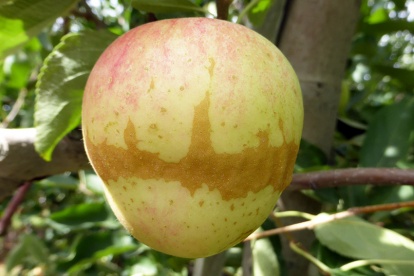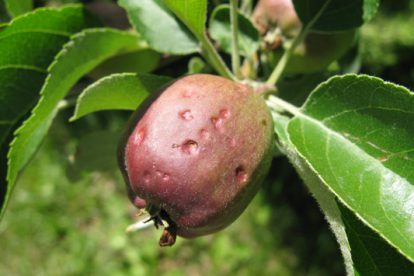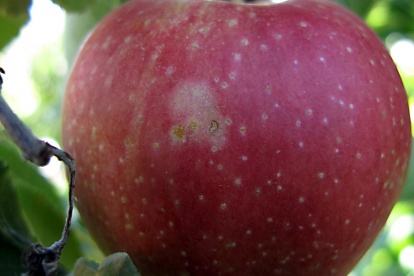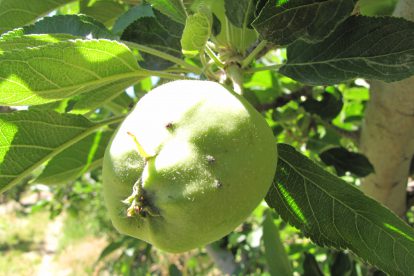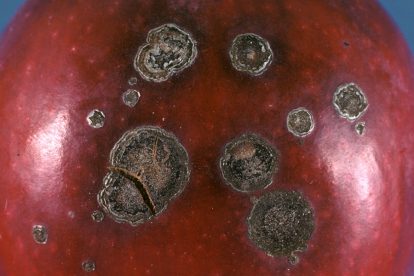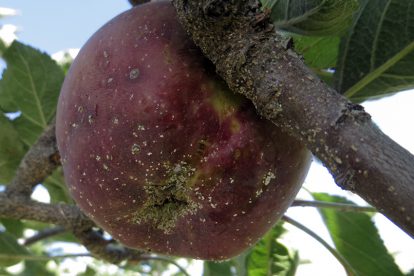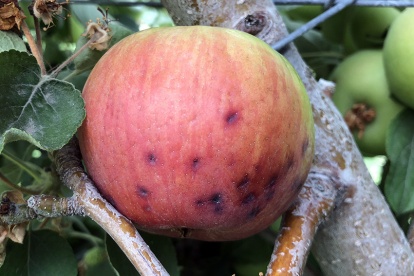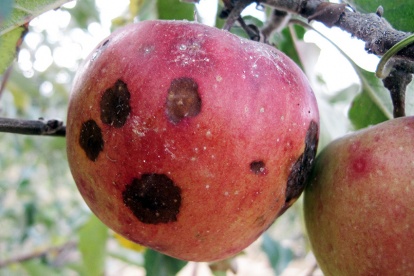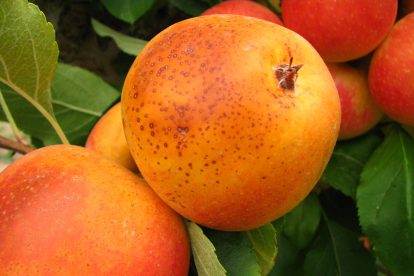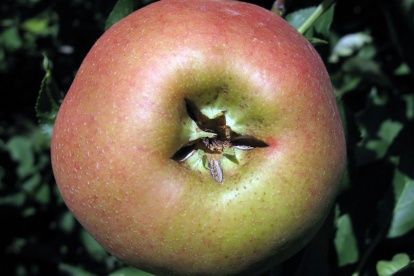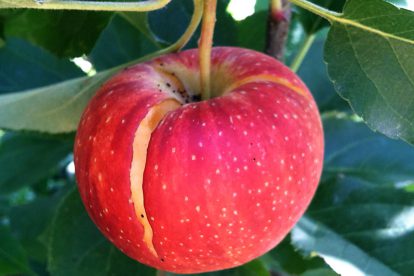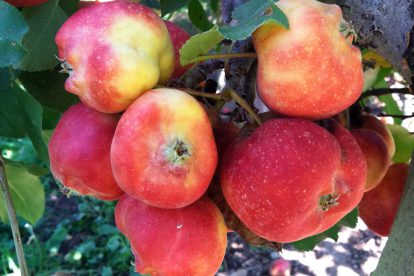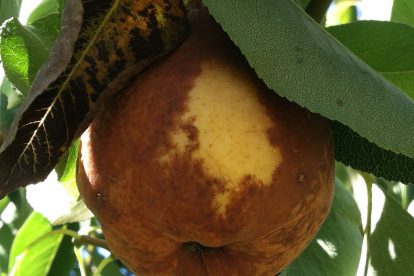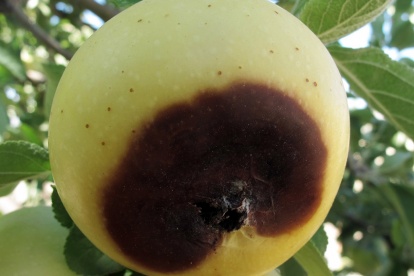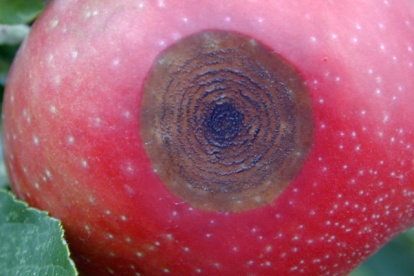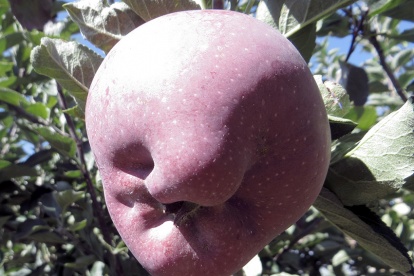In This Issue
- Prevent new coryneum blight (shothole) infections on peach and apricot by applying copper to trees when 50% of the leaves have fallen. Use enough pressure to blow off remaining leaves.
- Manage bacterial blight of sweet cherry with a fall copper application.
- For blister mites on apple and pear, apply sulfur or 1.5% horticultural oil.
- Help reduce overwintering pear psylla with oil or carbaryl now.
- Check out the apple image gallery below for damage that may be seen at harvest.
- General Orchard Chores
PEACH/NECTARINE, APRICOT, PLUM, CHERRY
Coryneum Blight
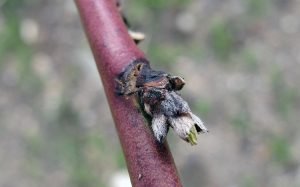
The time to treat coryneum blight (also known as shothole) is coming up. The optimal timing is when 50% of leaves have dropped from the trees.
Use a product that contains one of the following ingredients:
- copper (Bonide Copper, Lily Miller Microcop, Kocide, C-O-C-S, etc.)
- chlorothalonil (Daconil, Fertilome Broad Spectrum, Ortho Max Disease Control, etc.)
This disease affects many parts of the tree, including buds, small twigs, leaves, and fruit, so it is important to prevent new infections from happening in the fall.
When leaves drop, they leave behind a small open scar, and if any spores land on those scars under the right weather conditions, the fungus will invade the tissue and by the following spring, the associated bud will be killed. It is these bud infections that then lead to new leaf and fruit infections the following spring.
If trees have severe infections, it will take at least three years of diligent fall, spring, and summer treatments to suppress the disease incidence.
Bacterial Canker on Sweet Cherry
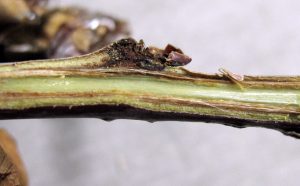
Bacterial canker (Pseudomonas syringae) is a disease of sweet cherry, causing oozing around dead buds, and twig and branch death.
Like coryneum blight, new infections enter trees through leaf scars in the fall. Research out of Oregon State University has shown that an application of copper in mid to late October can help reduce the incidence of this disease the following spring.
Sweet cherries that show oozing sap from dead buds and twigs, along with clusters of dead leaves or dead shoots, typically means an infection by bacterial canker.
APPLE, PEAR
Pear Psylla (Commercial Orchards)
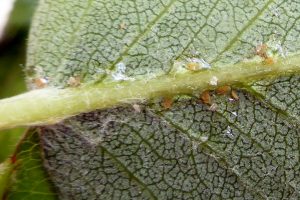
Early fall is a good time to treat for pear psylla before the adults migrate to protected areas in leaf litter or on tree bark for the winter.
To determine whether a post-harvest treatment is necessary, examine one shoot on at least 20 trees in your orchard (or 20 shoots on 1 to 2 trees) for the presence of nymphs (usually sitting in a drop of honeydew). If activity is seen on at least 5 shoots, a treatment is warranted.
Treatment: Oil or carbaryl are options.
Blister Mites (Backyard Orchards)
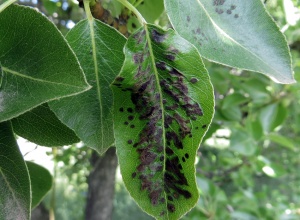
Blister mites can be treated now, and no later than just before leaf drop. This pest is more of an aesthetic problem, primarily on backyard trees, and does not harm the health of the tree. In fact, they serve as a food source for early-emerging predatory mites in the spring. (In turn, the predatory mites will take care of the harmful spider mites that are active during summer.)
Treatment: if necessary, one of the following could be used:
- 1.5-2% oil, thoroughly covering the bottoms of the leaves
- Sevin (carbaryl), alone or with 1% oil
- lime-sulfur (at this time of year only, it is OK to mix with 1% oil, but not on drought-stressed trees)
Blister mites belong to a group of mites called eriophyid mites (air-ee-oh-FYE-id). They are so small that they are invisible to the naked eye, but their feeding can cause visible symptoms.
Small raised blisters form on the leaves of pear and apple, which–by the middle of summer–look like brown or black leaf spots. In the fall, infested leaves will change color and drop before the healthy leaves.In early fall, just as the leaves start to turn color, the mites migrate to leaf buds to spend the winter under the bud scales. Their exposure at this time makes it a good opportunity to treat.
Apple Maladies Seen at Harvest – Image Gallery
Other Orchard Notes
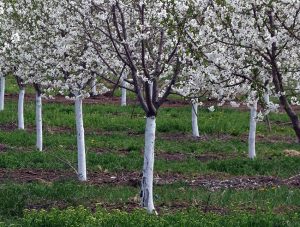
Prevent winter sunscald: In late winter, bark can be warmed by intense sunlight. If this warming is followed by a cold spell that night, the bark can be killed. Sunscald is one of the primary problems affecting young trees in Utah and is a major factor in the incidence of cytospora canker or flatheaded borers. Protect trunks by applying white tree wrap or painting the trunk and lower scaffold limbs with a 1:1 mixture of white latex paint to water. If using tree wrap, remove it in early April.
Plant new trees: Fall is a great time to plant because this is when trees put energy into root growth. Plant early enough to allow enough time for some root establishment before the ground freezes.
Do not prune: Do not prune any fruit trees now. Wait to conduct any pruning on apples, pears until late December through March. Prune peaches, cherries next spring after severe cold temperatures have passed (late March to early April).
Continue to irrigate: At this time of year, leaves on trees are changing color and dropping, while underground, major root growth is occurring. So it is important to maintain adequate but not excessive soil moisture from now until the soil freezes for winter.
Do not fertilize now: Roots will continue to grow all through fall, but nutrient uptake essentially ceases after the leaves have dropped. It is too late for any fall fertilizer applications, as whatever is applied will leach out of the soil.
Tree removal: Trees suffering from significant insect, disease, or other problems should be removed now. There is still time to install replacement plantings this fall.
Protect from mice, voles: Create or maintain at least 3 feet of clear space from around the base of each tree to help minimize rodents from feeding on bark and roots. Young trees are particularly susceptible to girdling because their trunk circumference is so small. Consider installing a physical barrier around the trunk and down into the soil up to 6 inches.

